Jacob Adler asks: “In Nishmat Ḥayyim (“The Breath of Life,” 1651), the Dutch rabbi Menasseh ben Israel writes of strange phenomena that supposedly occur in Asia: people making clothing from stone in China; families in Cochin, India, with right thighs swollen like elephants’; and people in Negapatam and Mylapore who can eat with their eyes, whether cucumbers and watermelons or the innards of enemies. Does anyone know of a source for these ideas?”
Send inquiries and answers to “Chapter and Verse,” Harvard Magazine, 7 Ware Street, Cambridge 02138, or via email to chapterandverse@harvardmag.com.







